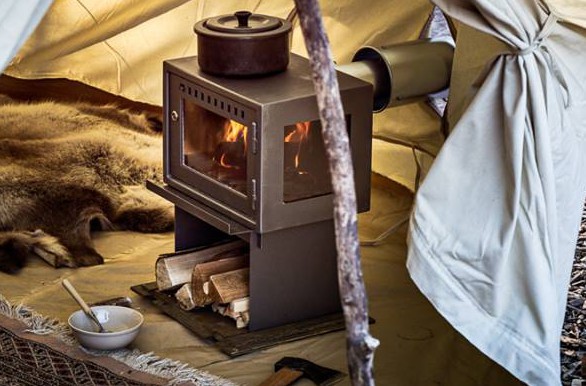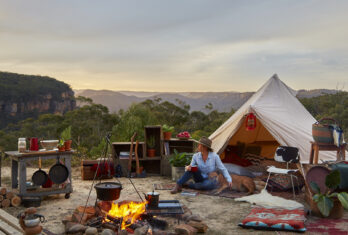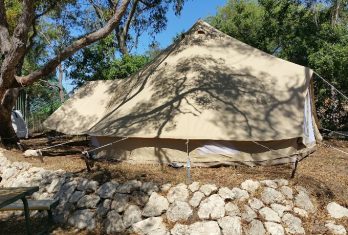‘Hot Tenting’ | A stove in a Bell Tent | Breathe Bell Tents | Considerations

A chimney can be installed into any of our bell tents using an Exit Flu:
There are many videos on youtube showing how this is done, such as the below:
These can be installed into any bell tent.
Please also consider the below:
- Burns
One of the most common hazards of hot tenting is the risk of burns from the stove. If you’re camping with children, multiple people or pets, then we recommend including a fireguard in your setup. Always wear fireproof gloves (welders gloves are a good option) when handling the stove or its components even after the fire has been extinguished.
- Ventilation:
Stoves consume oxygen to burn fuel, so it’s essential to provide adequate ventilation in your tent while the stove is in use. Leave windows or even doors open ensuring there is a continuous cycle of fresh air. We strongly recommend using a stove that has an external intake system such as the Winnerwell NOMAD Plus.
- Carbon Monoxide poisoning:
Do not underestimate the danger of carbon monoxide poisoning. Carbon Monoxide is an odourless and colourless gas produced when fuel doesn’t fully burn and consumes the available oxygen. Carbon Monoxide is difficult to detect so we advise that you invest in a battery-operated carbon monoxide alarm. They are inexpensive and can save your life. Also, be aware that exhaust fumes can escape your stove system into the tent either because there is some sort of blockage in the pipes or because a strong wind is blowing directly into the exit flue.
- Location, location, location:
When positioning the stove in your tent, consider its proximity to the tent door and ventilation. Avoid placing the stove in a location that obstructs your exit or where people frequently walk. It’s important to be mindful of keeping flammable items such as clothing and bedding away from the stove.
- Water source:
Ensure that you have access to a water source nearby, whether it’s a nearby stream or a container of water that you have near your tent.
- Fire extinguisher:
Keep a small fire extinguisher nearby in case of fire and consider sleeping with a knife in case you need to cut your way out of the tent in an emergency.
- Stove damper:
It pays to keep your Damper open so that carbon monoxide is continually drawn out of the firebox up through the chimney flue.
- Keep it clean:
You should regularly clean your stove and pipe sections to remove creosote that may block the chimney.
- Fuel storage:
Store your fuel ( wood or propane) well away from the tent and in a safe location to avoid the risk of fire.
Cleaning and maintaining your stove is key to a satisfying experience.
1.Clean the stove regularly:
Clean the stove after each use. Make sure to remove any leftover ash, soot, and debris from the firebox (spread this on your garden!).
- Use a chimney brush:
Check the flue for blockages. Creosote will quickly build up in your flue so clean this out with the appropriate-sized wire brush each and every time you camp.
- Use dry, properly seasoned hardwood:
Dry, seasoned wood burns better and produces less creosote, which means less cleaning. You will notice some species of hardwood will burn longer and hotter and with fewer gasses than others.
- Monitor the stovepipe temperature:
The stovepipe temperature should be 100c max – do not run your stove read hot as higher temperatures can damage the stove and is a hazard.
- Inspect the stove gaskets:
The stove gasket is a seal located around the inside of the stove door. Make sure they are not worn out or damaged. This will prevent air leaks that can reduce the stove’s efficiency and can be dangerous.
- Keep the stove dry:
Keep the stove dry to prevent rust and corrosion. When not in use, cover the stove with a waterproof cover and clean it with the appropriate cleaning solution.
- Store the stove properly:
Store the stove in a dry, cool place when not in use, and protect it from moisture and humidity.







